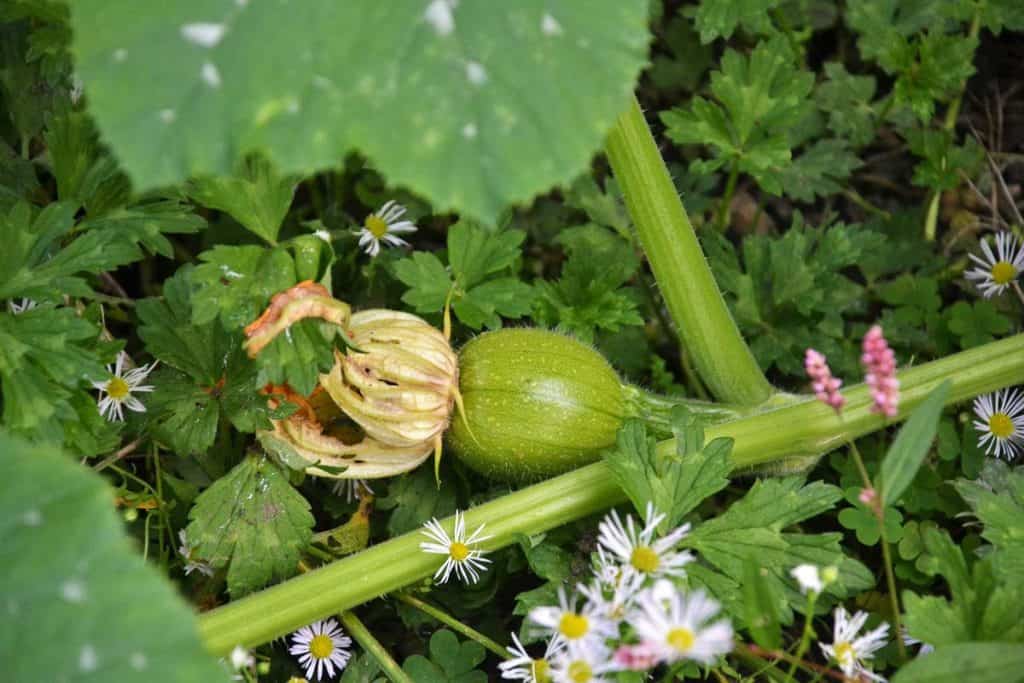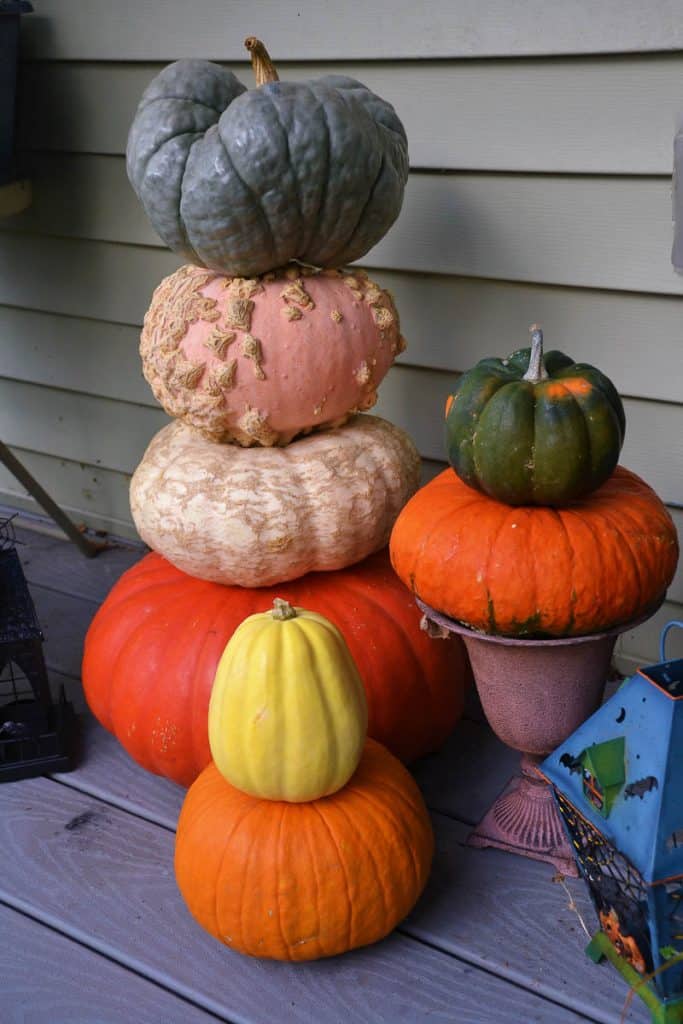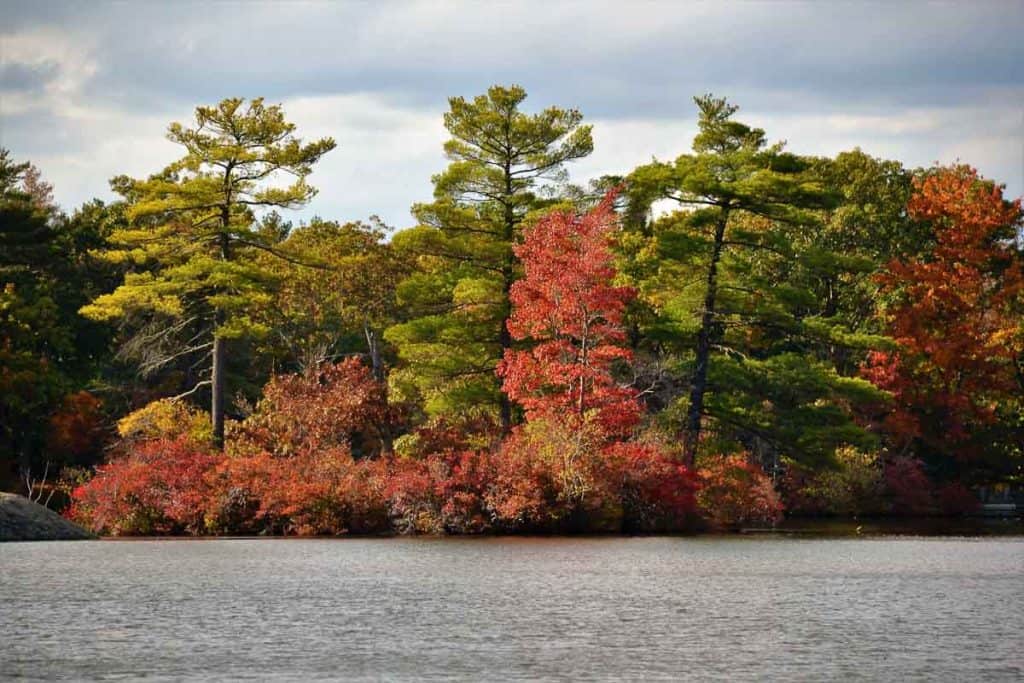Here’s what’s blooming in town this week to make your walks more enjoyable
Foliage colors have been intense this week. Breakheart Reservation is one of the best places to see turning leaves, especially around the lakes. Birch Pond as viewed from Walnut Street also has some spectacular foliage, and the effect is magnified as reflected in the water. The view from Vinegar Hill shows many patches of bright color across town, with some vivid yellows and oranges surrounding the spires of Town Hall. Almost any walk around town will reveal some spectacular foliage in the street trees and in gardens, as well as delightful pumpkin displays and Halloween decorations.
For the last three years, the week leading up to Halloween has had some wild weather events. In 2019 the Halloween night had heavy rain and wind, with downed branches and the cancellation of trick-or-treating in many communities. In 2020 we had unseasonable snow on the day before. This year it was a nor’easter Tuesday and Wednesday with heavy winds and rain again after summerlike sun and temperatures the previous week. Last Friday the air temperatures were warmer than water temperatures in Saugus ponds, resulting in many turtles sunning themselves on a rock in Silver Lake, but by the weekend things had changed. Winds and rain several days this week brought an end to the turtles’ sunbathing.
A small new garden has been planted near Breakheart’s Visitors’ Center. It still has a few flowers blooming, including coneflower (Echinacea sp.) and pink turtlehead (Chelone lyonii). Turtlehead is a treat you have to wait for until late summer, but it continues flowering until late fall. Pink turtlehead gets its name because its flowers resemble the head of a turtle poking out from its shell, with the mouth slightly open. This plant also happens to like habitat that would appeal to turtles – damp areas near ponds and streams. The pink turtlehead’s natural range is in mountains farther south, but it is hardy enough for gardens here. A closely related white flowering species, white turtlehead (Chelone glabra) may be seen in the wild in Massachusetts.
With all the horticultural splendors to be found at this time of year – amazing foliage, lush late blooming flowers, reblooming due to warm weather of many spring species, and fall specialty foods like apples and cider – at Halloween we have to acknowledge the glory of the pumpkin! All month the First Congregational Church lawn has held a bounty of orange globes, and many front yards and walkways around town also have bright orange focal points.
Betty Couture in Lynnhurst has an especially fetching display, with a long flight of front steps that set off her pumpkin collection very well. She has a few unusual varieties, including ‘Warty Goblin,’ which grew in her backyard from seeds produced by one of last Halloween’s pumpkins that was a gift from her son. ‘Warty Goblin’ is a bright orange pumpkin with raised greenish bumps and a green stem. Raised bumps, once considered a blemish that might discourage buyers, have become a popular feature. Several other bumpy varieties are also being sold, such as ‘Gargoyle,’ ‘Knucklehead’ and ‘Goosebumps.’
The rind of a ripe pumpkin can be other colors than orange – it can be nearly red, white to pale yellow, or even green. Some are very smooth and symmetrical, while others may be tall and narrow or have a melted and lopsided appearance. In some varieties, the ribs are prominent, while other varieties are known for their smooth, rounded shape. Classic round orange pumpkins are most often the heirloom varieties ‘Connecticut Field’ and ‘Howden’ developed by Massachusetts grower John Howden in the 1970’s. Some varieties are very small, such as ‘Wee Be Little,’ while other varieties are grown primarily for huge size, such as ‘Dill’s Atlantic Giant.’
This variety is usually chosen by those wanting to compete in pumpkin weigh-off contests. This year’s winner at the Topsfield Fair was 2,092 lbs. and grown by Alex Noel of Abington, Conn. The largest in the world, grown in Italy, weighed over 2,700 lbs. and broke the record set in 2016 in Belgium, while the smallest pumpkin in the world measured less than an inch long.
Size – large or small – may not be the only goal of those who grow pumpkins. Some are grown for flavor, as treats such as pumpkin pie. ‘New England Pie,’ which is also known as ‘Small Sugar Pie,’ is a very popular variety. There are even varieties grown for their seed quantity or quality – hull-less varieties advertised as seed pumpkins like ‘Kakai’ and ‘Styrian’ are especially bred for those who want to roast pumpkin seeds, although regular ones with the hulls are often used as a byproduct of pumpkin carving activities.
Editor’s Note: Laura Eisener is a landscape design consultant who helps homeowners with landscape design, plant selection and placement of trees and shrubs, as well as perennials. She is a member of the Saugus Garden Club and offered to write a series of articles about “what’s blooming in town” shortly after the outbreak of the COVID-19 pandemic. She was inspired after seeing so many people taking up walking.





